Kamashiki and Kamasue
In Chanoyu, the kama, 釜, kettle, is rested one of several utensils depending on the circumstances. There are three supports for the kama called kama–shiki, 釜敷, kettle-spread, which act like hot-pads: kami kama-shiki, 紙釜敷, paper kettle-spread; kumi kama-shiki, 組釜敷, braid kettle-spread, and ita kama-shiki, 板釜敷, wood kettle-spread.
When building the charcoal fire, sumi de-mae, 炭手前, charcoal hand-fore, the kama is placed temporarily on a pack of papers, kami kama-shiki, 紙釜敷, paper kettle-spread. For a simple sho-zumi, 初炭, first-charcoal, presentation in the presence of the guests, the kami kamashiki is held in the futokoro, 懐, the front folding of the kimono, and removed when needed.
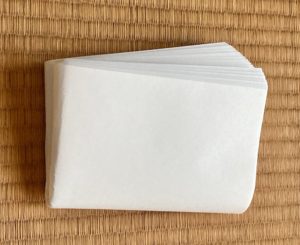
The kami kamashiki is the original kai-shi, 懐紙, heart-paper. The kami kamashiki is a pack of several sheets of paper that is folded twice is opposite directions. The number of sheets of paper in the pack varies from twenty to thirty. A simple, plain, pack of kami kamashiki is composed of twenty sheets, which when folded twice creates of pack of eighty sheets. The number eight, hachi, 八, is emblematic of Infinity in Space – sue-hiro, 末広, ends-wide.
Because of the thickness and number of sheets of paper, the exact measurements of the folded kami kamashiki are difficult to determine. The size of a single sheet of paper is 8.8 x 6 sun kujira-jaku. The number 88 is symbolic of Infinity in Space in all directions – omnipresence. In addition, the number 88 is identified with ya-ta, 八咫, eight-span, which refers to the Ya-ta Kagami, やたか, Eight-span Mirror, the sacred symbol of Shintō. The number six in Japanese, roku, 六, is symbolic of Infinity in Time. The kami kamashiki is emblematic of Infinity in Time and Space. Theoretically, the size of the folded kami kamashiki is one/quarter the size of a single sheet of paper, which is 4.4 x 3 sun kujira-jaku. Traditionally, measurements are given in kane-jaku, and 4.4 x 3 sun kujira-jaku are 5.5 x 3.75 sun kane-jaku.
In a very formal Tea presentation the kami kamashiki is placed on the sumi-tori, 炭斗, charcoal-measure, and not carried in the front folding of the kimono. When the charcoal fire is prepared before the guests enter the Tearoom, the kō-gō, 香合, incense-gather, may be displayed on the kami kamashiki in the tokonoma.

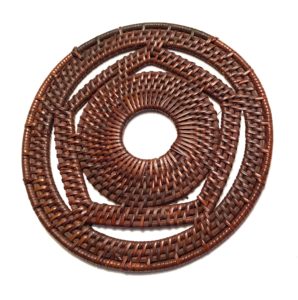
The inner ring has seven rings, the pentagon has three rings, the outer ring has four rings. Three and four is seven. There are fourteen rings.Seven and seven.
The heavenly constellations are divided into twenty-eight groupings; Ni-jū-ha-sshuku, 二十八宿, Two-ten-eight-mansions. These are divided into four groups of seven constellations in accord with the four directions, and are identified with the four celestial beasts: East – Sei-ryū, 青龍, Blue/green-dragon; South – Su-jaku, 朱雀, Vermilion-sparrow; West – Bya-kkō, 白虎, White-tiger, and North – Gen-bu, 玄武, Black-warrior.
According to Urasenke tradition, the kumi kamashiki is used during, go-zumi de-mae, 後炭手前, latter-charcoal hand-fore, rebuilding the charcoal fire after koicha and before usucha. The kumi kamashiki is placed in the sumitori for the presentation. Other Chanoyu traditions use the kumi kamashiki for the initial presentation of building the charcoal fire.
The measurements of the kumi kamashiki, 5 sun kane-jaku, and the kami kamashiki, 5.6 sun kane-jaku relate to each other 10 to .90909 to infinity.
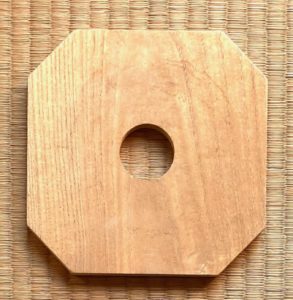
The ita-kama-shiki is a square board that has mitered corners to create an octagon, ha-kkaku, 八角, eight-corner. Eight is the number of Infinity in Space radiating in all eight directions: sue-hiro, 末広, end-wide. The ratio between the two widths of the itakamashiki is 10 to .88. These exceptional measurements can be written with the Kanji for rice, kome, 米, which places the utensil in the center of infinite world. The diameter of the hole is one sun kujira-jaku. The diameter of the hole in the kumi kamashiki is one sun kane-jaku: the diameters relate to each other 8 to 10.
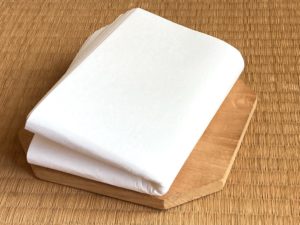
The long width of the kami kamashiki is the same as the long width of the ita kamashiki. The short width of the kami kamashiki is the same as the short width of the ita kamashiki.
In Chanoyu, water for tea is heated is a kama, 釜, kettle. When the kama is filled with water in the preparation room, mizu-ya, 水屋, water-room, it is set on a wooden frame, kama-sue, 釜据, kettle-set.
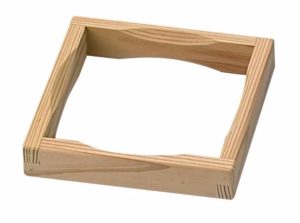
The inner edge of the frame is removed on both sides to accommodate the round bottom of a kettle. The construction of the kamasue has the half-lap joints made in either direction. The kamasue is not used in the cha-shitsu, 茶室, tea-room.
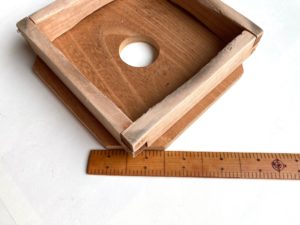
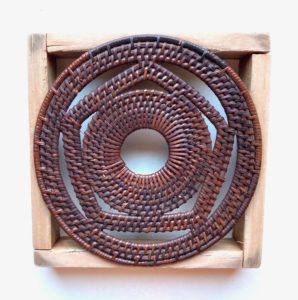
The diameter of the kumi kamashiki is 5 sun kane-jaku. The width of the kamasue is 5.2 sun kane-jaku. The inner edges of the kamasue are hollowed out to accommodate the round bottom of a kama. The distance between the outer edges of the concave sections of the kamasue very nearly approximates the width of the kumikamashiki. Perhaps their measurements were intended to be the same. This supposition is based on the seemingly arbitrary measurement of the kamasue at 5.2 sun kane-jaku. Perhaps the dimension was determined using the kujira-jaku, which would be 4.16 sun kujira-jaku. This seems an even more curious number, although four times four is sixteen. Contrast between the skillful simplicity of the kamasue and the superb intricacies of the kumi kamashiki is exquisite.
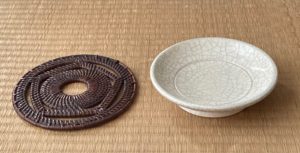
The kumi kamashiki supports the kama, the senzara supports the cha-sen, 茶筅, tea-whisk, and the cha-kin, 茶巾, tea-cloth, which are identified with the trigram for Ri, 離, Separation, that is symbolic of Fire. The kumi kamashiki is open, which is In, negative, and the senzara is solid, which is Yō.
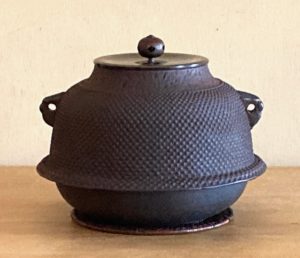
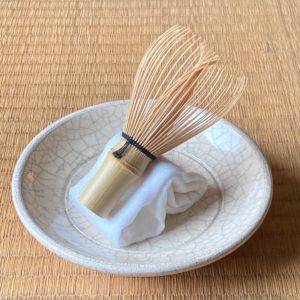
Left: shin-nari gama, 真形釜, true-form kettle, tetsu, 鉄, iron, by Kana-mori Jō-ei, 金森浄栄, Gold-woods Pure-splendor, resting on a kumi kama-shiki, 組釜敷, braid kettle-place. Right: cha-sen, 茶筅, tea-whisk, and cha-kin, 茶巾, tea-cloth, placed on a sen-zara, 筅皿, whisk-dish, ceramic, by Raku-nyū, 楽入, Pleasure-enter.
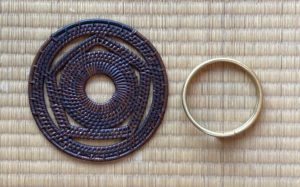
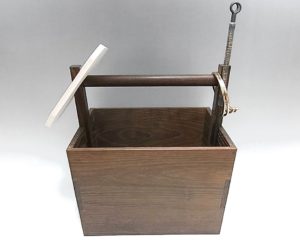
At the conclusion of the Tea presentation, the charcoal fire may be rebuilt in the presence of the guests, using utensils ordinarily used only in the mizuya. At that time, the ita kamashiki is used to support the kama, and is held on the upright handle of the hako sumi-tori.
For further study, see also: Sensu, Jizō Bon, and Kaishi and Kuromji

